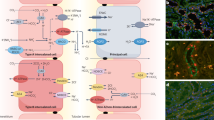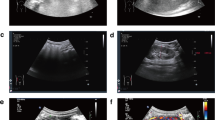Abstract
Background
Type IV renal tubular acidosis (RTA) is a severe complication of urinary tract infection (UTI) in infants. A detailed clinical and molecular analysis is still lacking.
Methods
Infants with UTI who exhibited features of type IV RTA were prospectively enrolled. Clinical, laboratory, and image characteristics and sequencing of genes responsible for phenotype were determined with follow-up.
Results
The study cohort included 12 infants (9 males, age 1–8 months). All exhibited typical type IV RTA such as hyperkalemia with low transtubular potassium gradient, hyperchloremic metabolic acidosis with positive urine anion gap, hypovolemic hyponatremia with renal salt wasting, and high plasma renin and aldosterone levels. Seven had hyperkalemia-related arrhythmia and two of them developed life-threatening ventricular tachycardia. With prompt therapy, all clinical and biochemical abnormalities resolved within 1 week. Five had normal urinary tract anatomy, and three of them carried genetic variants on NR3C2. Three variants, c.1645T>G (S549A), c.538G>A (V180I), and c.1-2C>G, on NR3C2 were identified in four patients. During follow-up, none of them had recurrent type IV RTA, but four developed renal scaring.
Conclusions
Genetic mutation on NR3C2 may contribute to the development of type IV RTA as a complication of UTI in infants without identifiable risk factors, such as urinary tract anomalies.
Similar content being viewed by others
Log in or create a free account to read this content
Gain free access to this article, as well as selected content from this journal and more on nature.com
or
References
Rodríguez-Soriano, J., Vallo, A., Oliveros, R. & Castillo, G. Transient pseudohypoaldosteronism secondary to obstructive uropathy in infancy. J. Pediatr. 103, 375–380 (1983).
Levin, T. L. et al. Salt losing nephropathy simulating congenital adrenal hyperplasia in infants with obstructive uropathy and/or vesicoureteral reflux–value of ultrasonography in diagnosis. Pediatr. Radiol. 21, 413–415 (1991).
Perez-Brayfield, M. R., Gatti, J., Smith, E. & Kirsch, A. J. Pseudohypoaldosteronism associated with ureterocele and upper pole moiety obstruction. Urology 57, 1178 (2001).
Schoen, E. J., Bhatia, S., Ray, G. T., Clapp, W. & To, T. T. Transient pseudohypoaldosteronism with hyponatremia-hyperkalemia in infant urinary tract infection. J. Urol. 167, 680–682 (2002).
Watanabe, T. Reversible secondary pseudohypoaldosteronism. Pediatr. Nephrol. 18, 486 (2003).
Bogdanović, R., Stajić, N., Putnik, J. & Paripović, A. Transient type 1 pseudo-hypoaldosteronism: report on an eight-patient series and literature review. Pediatr. Nephrol. 24, 2167–2175 (2009).
Gerigk, M., Glanzmann, R., Rascer, W. & Gnehm, H. E. Hyponatraemia and hyperkalaemia in acute pyelonephritis without urinary tract anomalies. Eur. J. Pediatr. 154, 582–584 (1995).
Kashimada, K., Omori, T., Takizawa, F. & Mizutani, S. Two cases of transient pseudohypoaldosteronism due to group B Streptococcus pyelonephritis. Pediatr. Nephrol. 23, 1569–1570 (2008).
Bowden, S. A. et al. Autosomal dominant pseudohypoaldosteronism type 1 in an infant with salt wasting crisis associated with urinary tract infection and obstructive uropathy. Case Rep. Endocrinol. 2013, 524647 (2013).
Melzi, M. L. et al. Acute pyelonephritis as a cause of hyponatremia/hyperkalemia in young infants with urinary tract malformations. Pediatr. Infect. Dis. J. 114, 56–59 (1995).
Patel, K., Charron, M., Hoberman, A., Brown, M. L. & Rogers, K. D. Intra- and interobserver variability in interpretation of DMSA scans using a set of standardized criteria. Pediatr. Radiol. 23, 506–509 (1993).
Lebowitz, R. L., Olbing, H., Parkkulainen, K. V., Smellie, J. M. & Tamminen-Möbius, T. E. International system of radiographic grading of vesicoureteric reflux. International Reflux Study in Children. Pediatr. Radiol. 115, 105–109 (1985).
Al-Dahhan, J., Haycock, G. B., Chantler, C. & Stimmler, L. Sodium homeostasis in term and preterm neonates. I. Renal aspects. Arch. Dis. Child. 58, 335–342 (1983).
Martinerie, L. et al. Physiological partial aldosterone resistance in human newborns. Pediatr. Radiol. 66, 323–328 (2009).
Martinerie, L. et al. Low renal mineralocorticoid receptor expression at birth contributes to partial aldosterone resistance in neonates. Endocrinology 150, 4414–4424 (2009).
Klahr, S. Obstructive nephropathy. Intern. Med. 39, 3553–3561 (2000).
Rugo, H. S., O'Hanley, P. & Bishop, A. G. Local cytokine production in a murine model of Escherichia coli pyelonephritis. J. Clin. Invest. 89, 1032–1039 (1992).
Husted, R. F., Matsushita, K. & Stokes, J. B. Induction of resistance to mineralocorticoid hormone in cultured inner medullary collecting duct cells by TGF-beta 1. Am. J. Physiol. 267, F767–F775 (1994).
Caverzasio, J., Rizzoli, R., Dayer, J. M. & Bonjour, J. P. Interleukin-1 decreases renal sodium reabsorption: possible mechanism of endotoxin-induced natriuresis. Am. J. Physiol. 252, F943–F946 (1987).
Bayer, M. & Kutílek, S. A hereditary form of pseudohypoaldosteronism may be manifested in the course of pyelonephritis. Acta Paediatr. 82, 504 (1993).
De Seigneux, S., Leroy, V. & Ghzili, H. NF-kappaB inhibits sodium transport via down-regulation of SGK1 in renal collecting duct principal cells. J. Biol. Chem. 283, 25671–25681 (2008).
Jeong, H. A., Park, Y. K. & Jung, Y. S. Pseudohypoaldosteronism in a newborn male with functional polymorphisms in the mineralocorticoid receptor genes. Ann. Pediatr. Endocrinol. Metab. 20, 230–234 (2015).
Viengchareun, S. et al. The mineralocorticoid receptor: insights into its molecular and (patho)physiological biology. Nucl. Recept. Signal. 5, e012–e027 (2007).
Geller, D. S., Zhang, J. & Zennaro, M. C. Autosomal dominant pseudohypoaldosteronism type 1: mechanisms, evidence for neonatal lethality, and phenotypic expression in adults. J. Am. Soc. Nephrol. 17, 1429–1436 (2006).
Thies, K. C. et al. Ventricular flutter in a neonate–severe electrolyte imbalance caused by urinary tract infection in the presence of urinary tract malformation. J. Emerg. Med. 18, 47–50 (2000).
Mastrandrea, L. D., Martin, D. J. & Springate, J. E. Clinical and biochemical similarities between reflux/obstructive uropathy and salt-wasting congenital adrenal hyperplasia. Clin. Pediatr. 44, 809–812 (2005).
Acknowledgements
This study was supported in part by research fund of Chang Gung Memorial Hospital (CMRPG3H0361, CMRPG3H0911, CMRPG3I0021), the Ministry of Science and Technology (MOST 106-2314-B-182A-123-MY3), and the Research Fund of Tri-Service General Hospital (TSGH-C106-110, TSGH-C108-132). We thank Professor Martin Konrad for critical review of the revised manuscript and Professor Yu-Ching Chou for the critical help of statistical analysis.
Author information
Authors and Affiliations
Contributions
M.-H.T. and S.-H.L. interpreted the data analyses and reviewed and revised the manuscript. J.-L.H., S.-M.H., and J.-D.T. carried out the data analysis, assisted with interpretation of the data analyses, and reviewed and revised the manuscript for important intellectual content. T.-W.W. assisted with acquisition of the data, interpreted the data analyses, and reviewed and revised the manuscript for important intellectual content. W.-L.F. and J.-J.D. conceptualized and designed the study, assisted with acquisition of data, and provided analysis and interpretation of the data. All authors approved the final manuscript as submitted and agree to be accountable for all aspects of the work.
Corresponding author
Ethics declarations
Competing interests
The authors declare no competing interests.
Additional information
Publisher’s note Springer Nature remains neutral with regard to jurisdictional claims in published maps and institutional affiliations.
Rights and permissions
About this article
Cite this article
Tseng, MH., Huang, JL., Huang, SM. et al. Clinical features, genetic background, and outcome in infants with urinary tract infection and type IV renal tubular acidosis. Pediatr Res 87, 1251–1255 (2020). https://doi.org/10.1038/s41390-019-0727-7
Received:
Revised:
Accepted:
Published:
Issue date:
DOI: https://doi.org/10.1038/s41390-019-0727-7
This article is cited by
-
Transient secondary pseudo-hypoaldosteronism in infants with urinary tract infections: systematic literature review
European Journal of Pediatrics (2024)
-
Renal pseudohypoaldosteronism type 1—an adult case series including a novel gene variant
Endocrine (2024)
-
Pseudo-hypoaldosteronism secondary to infantile urinary tract infections: role of ultrasound
Italian Journal of Pediatrics (2022)
-
Aldosterone signaling defect in young infants: single-center report and review
BMC Endocrine Disorders (2021)



